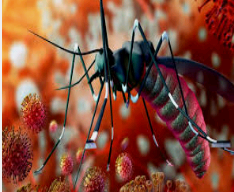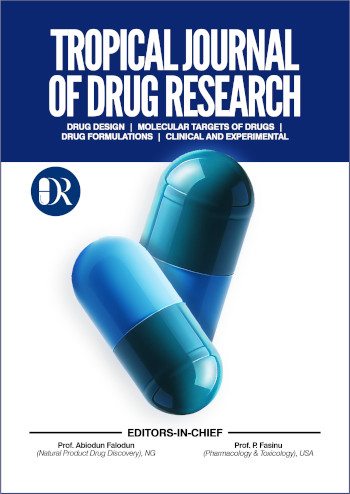GCMS analysis and larvicidal activity of <i>Luffa cylindrica</i> leaf extracts against mosquito larvae from Wassa Internally Displaced Person Camp, Abuja, Nigeria
DOI:
https://doi.org/10.26538/tjdr/v1i1.1Keywords:
Internally Displaced Person (IDP) Camp, Larvae, Luffa cylindrical, Mortality rate, Mosquitoes emergence, PupaeAbstract
Purpose: The study evaluated the larvicidal activity of Luffa cylindrica leaf extracts against mosquito larvae from Wassa Internally Displaced Person (IDP) Camp, Abuja, Nigeria.
Methods: Larvae were collected from Wassa IDP, Abuja, Nigeria and introduced into 100, 200 and 400 µg/mL of aqueous and methanol L. cylindrica leaf extracts, azadirachtin at 100 µg/mL, 1% DMSO and 1% Triton X100 were used as controls. Larvae mortality was monitored at 24, 48 and 72 hours. For pupae and mosquito emergence rate, the larvae were reared in the laboratory to pupae stage and then treated with 100, 200 and 400 µg/mL of aqueous and methanol L. cylindrica leaf extracts and the rate of mosquito emergence was monitored. Data were presented as mean and subjected to probit analysis to determine the LC50 and LC90 concentrations. The phytoconstituent of the methanol extract was determined using gas chromatography-mass spectrometry (GCMS) analysis.
Results: At 72 hours, the methanol L. cylindrica extract recorded 46.88±15.46% larvae mortality rate compared with the aqueous L. cylindrica extract with 47.50±17.08%, azadirachtin with 72.50±32.02% and 100.00% mortality rate with triton X100 treatment respectively. The probit lethal concentration kills (LC50 and LC90) were found to be 609.86 and 10780.23 µg/mL for the methanol L. cylindrica extract and 415.68 and 7876.56 µg/mL for the aqueous L. cylindrica extract. The methanol extract had significantly (p<0.05) higher pupae mortality rate (83.33%) compared with the aqueous extract (53.33%) and a 16.67% mosquito emergence rate compared with 56.67% respectively. Identified phytoconstituents included 1-(4-nitrophenyl) piperazine, phenol, propanoic acid, carbamothioic acid, hexadecanoic acid and 1,2,4-benzenetricarboxylic acid.
Conclusion: Luffa cylindrica leaf extracts are biodegradable and eco-friendly, which could serve as an important larvicidal source, preventing the emergence of adult mosquitoes.
Downloads
References
World Health Organization (2023). World malaria report 2023. Geneva: https://www.who.int/publications/i/item/9789240086173
Abubakar Y, Tijjani H, Egbuna C, Adetunji CO, Kala S, Kryeziu TL, Ifemeje JC, Kingsley C, Patrick-Iwuanyanwu KC. Pesticides, History, and Classification, Chapter 3, Natural Remedies for Pest, Disease and Weed Control, Academic Press, Elsevier Inc. 2020; Pp 29 – 42.
Soderlund DM. Toxicology and mode of action of pyrethroid insecticides. In Hayes' Handbook of Pesticide Toxicology (Pp. 1665-1686). Academic Press. 2017.
Hemingway J, Ranson H, Magill A, Kolaczinski J, Fornadel C, Gimnig J, Coetzee M, Simard F, Roch DK, Hinzoumbe CK, Pickett J, Schellenberg D, Gething P, Hoppé M, Hamon N. Averting a malaria disaster: Will insecticide resistance derail malaria control? The Lancet. 2016); 87(10029): 1785-1788.
Isman MB. Botanical insecticides in the twenty-first century—Fulfilling their promise? Annu. Rev. Entomol. 2020; 65: 233-249.
Verma S, Rajbala. Cylindrica Sponge Gourd (Cucurbitaceae): A Medicinal Green Herb. Int. J. Adv. Sci. Res. 2018; 3: 53-55.
Saliu OA, Akanji MA, Idowu OA. Luffa cylindrica (Linn. M. J. Roem) reduce oxidative stress in vivo in Plasmodium berghei infected albino mice. East Afr Med J. 2022a;14(04): 145-151.
Saliu OA, Akanji MA, Saliu NB, Idowu OA. In vivo investigation provides new insights into the antiplasmodial activities of Luffa cylindrica leaf extracts in Plasmodium berghei infected mice. East Afr Med J. 2022b; 99(4): 4686-4700.
Saliu OA, Akanji MA, Idowu OA, Saliu NB. Pharmacological evidence favouring the ethnomedicinal use of Luffa cylindrica leaf in the relief of pain and fever. Direct Res. J. Health Pharm. 2019; 7(4): 38-42.
Onyegbule F, Okoye C, Chukwunwejim C, Umeokoli B, Eze P. Evaluation of antioxidant, anti-inflammatory and antimicrobial activities of the leaf extracts of Luffa cylindrica. J Herb Sci. 2018; 8: 101–109.
El-Shemy H, Aboul-Enein AM, Aboul-Enein MA, Fujita K. Luffa cylindrica: An economic plant with promising natural products and biological activities. J. Agric. Food Chem. 2020; 68(11), 3135-3154.
Sukumar K, Perich MJ, Boobar LR. Botanical derivatives in mosquito control: a review. J Am Mosq Control Assoc. 1991; 7(2): 210-237.
Mordue (Luntz) AJ, Nisbet AJ. Azadirachtin from the neem tree Azadirachta indica: its action against insects. Anais da Sociedade Entomológica do Brasil. 2000; 29(4):615–632.
Lee S, Kim J., Lee S. Floating of the lobes of mosquito (Aedes togoi) larva for respiration. Sci Rep. 2017; 7: 43050.
Sudarmaja M. Pengaruh Air Sabun dan Detergen terhadap Daya Tetas Telur Aedes aegypti. Medicina. 2008; 39 (1): 56-58.
Awad AM, Kumar P, Ismail-Fitry MR, Jusoh S, Ab Aziz MF, Sazili AQ. Green Extraction of Bioactive Compounds from Plant Biomass and Their Application in Meat as Natural Antioxidant. Antioxidants (Basel). 2021; 10(9):1465.
Tijjani H, Egbuna, C, Luka CD. Biosynthesis of Phytochemicals, In Phytochemistry, Volume 1, Chapter 2, Fundamentals, Modern Techniques, and Applications, Apple Academic Press Inc. Canada. 2018; Pp 37-78.
Rahman MM, Rahaman MS, Islam MR, Rahman F, Mithi FM, Alqahtani T, Almikhlafi MA, Alghamdi SQ, Alruwaili AS, Hossain MS, Ahmed M, Das R, Emran TB, Uddin MS. Role of Phenolic Compounds in Human Disease: Current Knowledge and Future Prospects. Molecules. 2021; 27(1): 233.

Downloads
Published
Issue
Section
License

This work is licensed under a Creative Commons Attribution-NonCommercial-ShareAlike 4.0 International License.




